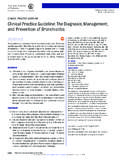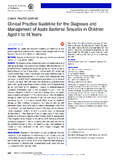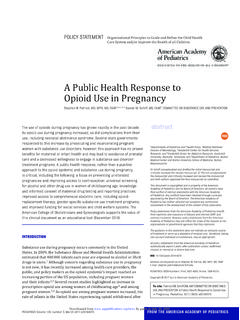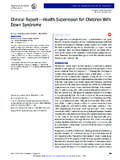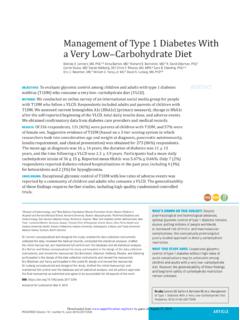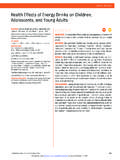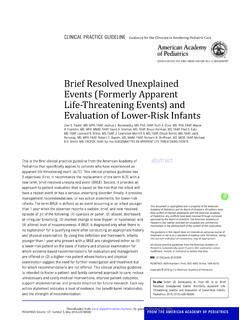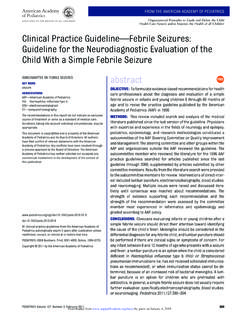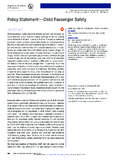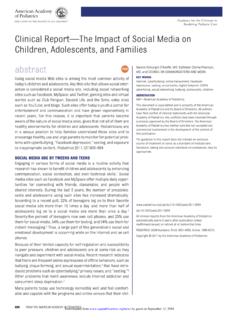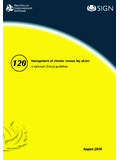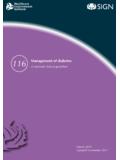Transcription of CLINICAL PRACTICE GUIDELINE Urinary Tract …
1 CLINICAL PRACTICE GUIDELINEU rinary Tract Infection: CLINICAL PRACTICE GUIDELINE forthe Diagnosis and Management of the Initial UTI inFebrile Infants and Children 2 to 24 MonthsabstractOBJECTIVE:To revise the American Academy of Pediatrics practiceparameter regarding the diagnosis and management of initial urinarytract infections (UTIs) in febrile infants and young :Analysis of the medical literature published since the lastversion of the GUIDELINE was supplemented by analysis of data providedby authors of recent publications. The strength of evidence supportingeach recommendation and the strength of the recommendation wereassessed and :Diagnosis is made on the basis of the presence of bothpyuria and at least 50 000 colonies per mL of a single uropathogenicorganism in an appropriately collected specimen of urine. After 7 to 14days of antimicrobial treatment, close CLINICAL follow-up monitoringshould be maintained to permit prompt diagnosis and treatment ofrecurrent infections.
2 Ultrasonography of the kidneys and bladdershould be performed to detect anatomic abnormalities. Data from themost recent 6 studies do not support the use of antimicrobial prophy-laxis to prevent febrile recurrent UTI in infants without vesicoureteralreflux (VUR) or with grade I to IV VUR. Therefore, a voiding cystoure-thrography (VCUG) is not recommended routinely after the first UTI;VCUG is indicated if renal and bladder ultrasonography reveals hydro-nephrosis, scarring, or other findings that would suggest either high-grade VUR or obstructive uropathy and in other atypical or complexclinical circumstances. VCUG should also be performed if there is arecurrence of a febrile UTI. The recommendations in this GUIDELINE donot indicate an exclusive course of treatment or serve as a standard ofcare; variations may be appropriate. Recommendations about antimi-crobial prophylaxis and implications for performance of VCUG arebased on currently available evidence.
3 As with all American Academy ofPediatrics CLINICAL guidelines , the recommendations will be reviewedroutinely and incorporate new evidence, such as data from the Ran-domized Intervention for Children With Vesicoureteral Reflux (RIVUR) :Changes in this revision include criteria for the diag-nosis of UTI and recommendations for ;128:595 610 SUBCOMMITTEE ON Urinary Tract INFECTION, STEERINGCOMMITTEE ON QUALITY IMPROVEMENT AND MANAGEMENTKEY WORDS Urinary Tract infection, infants, children, vesicoureteral reflux,voiding cystourethrographyABBREVIATIONSSPA suprapubic aspirationAAP American Academy of PediatricsUTI Urinary Tract infectionRCT randomized controlled trialCFU colony-forming unitVUR vesicoureteral refluxWBC white blood cellRBUS renal and bladder ultrasonographyVCUG voiding cystourethrographyThis document is copyrighted and is property of the AmericanAcademy of Pediatrics and its Board of Directors.
4 All authorshave filed conflict of interest statements with the AmericanAcademy of Pediatrics. Any conflicts have been resolved througha process approved by the Board of Directors. The AmericanAcademy of Pediatrics has neither solicited nor accepted anycommercial involvement in the development of the content ofthis recommendations in this report do not indicate an exclusivecourse of treatment or serve as a standard of medical , taking into account individual circumstances, may CLINICAL PRACTICE guidelines from the American Academy ofPediatrics automatically expire 5 years after publication unlessreaffirmed, revised, or retired at or before that (ISSN Numbers: Print, 0031-4005; Online, 1098-4275).Copyright 2011 by the American Academy of PediatricsCOMPANION PAPERS:Companions to this article can be foundon pages 572 and e749, and online at and THE AMERICAN ACADEMY OF PEDIATRICSPEDIATRICS Volume 128, Number 3, September 2011595 by guest on January 1, from INTRODUCTIONS ince the early 1970s, occult bactere-mia has been the major focus of con-cern for clinicians evaluating febrileinfants who have no recognizablesource of infection.
5 With the introduc-tion of effective conjugate vaccinesagainstHaemophilus influenzaetypeb andStreptococcus pneumoniae(which have resulted in dramatic de-creases in bacteremia and meningi-tis), there has been increasing appre-ciation of the Urinary Tract as the mostfrequent site of occult and serious bac-terial infections. Because the clinicalpresentation tends to be nonspecific ininfants and reliable urine specimensfor culture cannot be obtained withoutinvasive methods (urethral cathe-terization or suprapubic aspiration[SPA]), diagnosis and treatment maybe delayed. Most experimental andclinical data support the concept thatdelays in the institution of appropriatetreatment of pyelonephritis increasethe risk of renal ,2 This CLINICAL PRACTICE GUIDELINE is a re-vision of the PRACTICE parameter pub-lished by the American Academy ofPediatrics (AAP) in was devel-oped by a subcommittee of the Steer-ing Committee on Quality Improvementand Management that included physi-cians with expertise in the fields of ac-ademic general pediatrics, epidemiol-ogy and informatics, pediatricinfectious diseases, pediatric nephrol-ogy, pediatric PRACTICE , pediatric radi-ology, and pediatric urology.
6 The AAPfunded the development of this guide-line; none of the participants had anyfinancial conflicts of interest. Theguideline was reviewed by multiplegroups within the AAP (7 committees, 1council, and 9 sections) and 5 externalorganizations in the United States andCanada. The GUIDELINE will be reviewedand/or revised in 5 years, unless newevidence emerges that warrants revi-sion sooner. The GUIDELINE is intendedfor use in a variety of CLINICAL settings(eg, office, emergency department, orhospital) by clinicians who treat in-fants and young children. This text is asummary of the analysis. The data onwhich the recommendations arebased are included in a companiontechnical the 1999 PRACTICE parameter, thisrevision focuses on the diagnosis andmanagement of initial Urinary Tract in-fections (UTIs) in febrile infants andyoung children (2 24 months of age)who have no obvious neurologic or an-atomic abnormalities known to be as-sociated with recurrent UTI or renaldamage.
7 (For simplicity, in the remain-der of this GUIDELINE the phrase fe-brile infants is used to indicate febrileinfants and young children 2 24months of age.) The lower and upperage limits were selected because stud-ies on infants with unexplained fevergenerally have used these age limitsand have documented that the preva-lence of UTI is high ( 5%) in this agegroup. In those studies, fever was de-fined as temperature of at least C( F); accordingly, this definitionof fever is used in this GUIDELINE . Ne-onates and infants less than 2months of age are excluded, becausethere are special considerations inthis age group that may limit the ap-plication of evidence derived fromthe studies of 2- to 24-month-old chil-dren. Data are insufficient to deter-mine whether the evidence gener-ated from studies of infants 2 to 24months of age applies to childrenmore than 24 months of provide evidence for the GUIDELINE , 2literature searches were conducted,that is, a surveillance of Medline-listedliterature over the past 10 years forsignificant changes since the guidelinewas published and a systematic re-view of the literature on the effective-ness of prophylactic antimicrobialtherapy to prevent recurrence of fe-brile UTI/pyelonephritis in childrenwith vesicoureteral reflux (VUR).
8 Thelatter was based on the new and grow-ing body of evidence questioning theeffectiveness of antimicrobial prophy-laxis to prevent recurrent febrile UTI inchildren with VUR. To explore this par-ticular issue, the literature search wasexpanded to include trials publishedsince 1993 in which antimicrobial pro-phylaxis was compared with no treat-ment or placebo treatment for chil-dren with VUR. Because all except 1 ofthe recent randomized controlled tri-als (RCTs) of the effectiveness of pro-phylaxis included children more than24 months of age and some did notprovide specific data according tograde of VUR, the authors of the 6 RCTswere contacted; all provided raw datafrom their studies specifically ad-dressing infants 2 to 24 months of age,according to grade of VUR. Meta-analysis of these data was from the literature searchesand meta-analyses were provided tocommittee members.
9 Issues wereraised and discussed until consensuswas reached regarding recommenda-tions. The quality of evidence support-ing each recommendation and thestrength of the recommendation wereassessed by the committee membermost experienced in informatics andepidemiology and were graded ac-cording to AAP policy5(Fig 1).The subcommittee formulated 7 rec-ommendations, which are presentedin the text in the order in which a clini-cian would use them when evaluatingand treating a febrile infant, as well asin algorithm form in the Appendix. Thisclinical PRACTICE GUIDELINE is not in-tended to be asole source of guidancefor the treatment of febrile infants withUTIs. Rather, it is intended to assist clini-cians in decision-making. It is not in-tended to replace CLINICAL judgment or to596 FROM THE AMERICAN ACADEMY OF PEDIATRICS by guest on January 1, from establish an exclusive protocol for thecare of all children with this Statement 1If a clinician decides that a febrileinfant with no apparent source forthe fever requires antimicrobialtherapy to be administered be-cause of ill appearance or anotherpressing reason, the clinicianshould ensure that a urine speci-men is obtained for both cultureand urinalysis before an antimicro-bial agent is administered; thespecimen needs to be obtainedthrough catheterization or SPA, be-cause the diagnosis of UTI cannotbe established reliably through cul-ture of urine collected in a bag(evidence quality: A; strongrecommendation).
10 When evaluating febrile infants, clini-cians make a subjective assessment ofthe degree of illness or toxicity, in ad-dition to seeking an explanation for thefever. This CLINICAL assessment deter-mines whether antimicrobial therapyshould be initiated promptly and af-fects the diagnostic process regardingUTI. If the clinician determines that thedegree of illness warrants immediateantimicrobial therapy, then a urinespecimen suitable for culture shouldbe obtained through catheterization orSPA before antimicrobial agents areadministered, because the antimicro-bial agents commonly prescribed insuch situations would almost certainlyobscure the diagnosis of has been considered the standardmethod for obtaining urine that is un-contaminated by perineal flora. Vari-able success rates for obtaining urinehave been reported (23% 90%).6 8 When ultrasonographic guidance isused, successrates ,10 Thetechnique has limited risks, but tech-nical expertise and experience arerequired, and many parents and phy-sicians perceive the procedure asunacceptably invasive, comparedwith catheterization.
